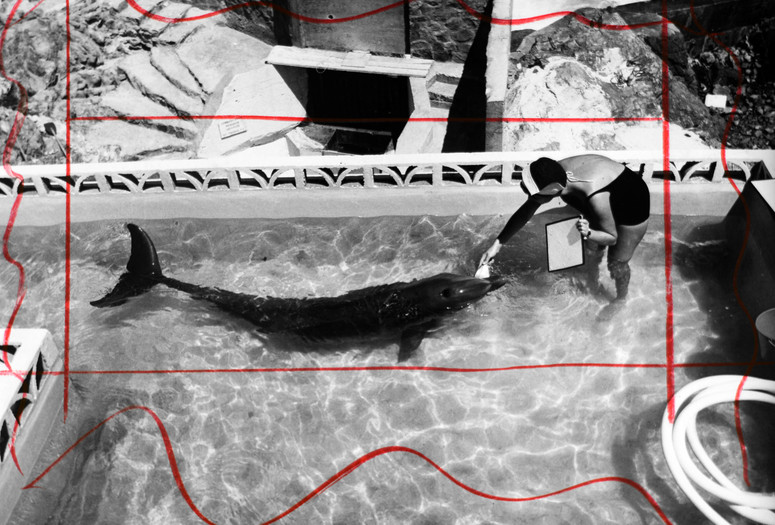
Organized in conjunction with Joan Jonas: Good Night Good Morning, this panel discussion, titled “The Aquatic Brain,” brings Joan Jonas into conversation with a group of thinkers—artist and researcher Joshua Citarella, historian of science Samantha Muka, media theorist John Shiga, and marine biologist and frequent Jonas collaborator David Gruber—whose work considers the promise and limits of multispecies cohabitation, the relationship between ecology and the built environment, and the intelligence of nonhuman animal life.
The wondrous agency of the natural world has been a concern throughout Jonas’s 50-year career: “From the very beginning nature has been a context for my work,” Jonas recalls. “I have had a close relationship to the outdoors from early childhood.”
More recently, Jonas has returned to environmental concerns, from projects that explore the vulnerability of endangered species and ecosystems to Jonas’s Moving Off the Land II, a large-scale installation focused on the sentience of nonhuman marine life. With this work, Jonas inaugurated a sustained engagement with David Gruber, a marine biologist renowned for his use of AI technology to translate the communication of sperm whales and his research developing cameras that approximate the perception of marine mammals. Landmark ocean footage by Gruber, including a never-before-captured birth of a sperm whale, appears in two of Jonas’s works in the exhibition, the aforementioned Moving Off the Land II, and Jonas’s most recent work, To Touch Sound, commissioned by MoMA for Joan Jonas: Good Night Good Morning.
Participants
Joan Jonas began her decades-long career in New York’s vibrant Downtown art scene of the 1960s and ’70s, where she was one of the first artists to work in performance and video. Drawing influence from literature, Noh and Kabuki theater, and art history, her early experimental works probed how a given element—be it distance, mirrors, the camera, or even wind—could transform one’s perception. Jonas continues to produce her most urgent work through immersive multimedia installations that address climate change and kinship between species. “Despite my interest in history,” she has said, “my work always takes place in the present.”
Joshua Citarella is an artist and Internet culture researcher based in New York City. He is the founder of Do Not Research. He has taught at the School of Visual Arts and the Rhode Island School of Design (RISD), and has served as an outside advisor at Carnegie Mellon University and Tufts University. His work is included in the collections of the Stedelijk Museum, Netherlands, and the Hood Museum of Art. His publications are included in the libraries of the School of Visual Art, Yale University, Harvard University, RISD, and the Massachusetts Institute of Technology, among others.
David Gruber is the founder and president of Project CETI (Cetacean Translation Initiative), a nonprofit, interdisciplinary scientific and conservation initiative on a mission to listen to and translate the communication of sperm whales. He is a distinguished professor of biology and environmental ccience at the City University of New York, Baruch College, and the CUNY Graduate Center. His interdisciplinary research bridges animal communication, climate science, marine biology, microbiology, and molecular biology, and his inventions include technology to perceive the underwater world (“shark-eye camera”) from the perspective of marine animals.
John Shiga is a professor in the School of Professional Communication at Toronto Metropolitan University, where he teaches urban media, cross-cultural communication, knowledge translation, science communication, and communication for social change. His current research and creative practice focuses on the politics of underwater sound. Through archival research and audiovisual installations, he explores the intertwined histories of ocean science, nuclear imperialism, and environmental sensing infrastructures. He has published work on the history of digital audio, intellectual property, media theory, and interspecies communication.
Samantha Muka is an assistant professor in the School of Humanities, Arts and Social Sciences at the Stevens Institute of Technology. Her research looks at the history of marine science, with special emphasis on the history of technological development and deployment to study and shape the marine environment. Her first book, Oceans under Glass, looks at how a large network of aquarium users have developed and shared craft knowledge about how to maintain marine organisms in captivity. Her current project examines the history of ocean waste management to see how engineering and management have evolved along with public perceptions of the marine environment.
The Emilio Ambasz Institute for the Joint Study of the Built and the Natural Environment is a platform for fostering dialogue, promoting conversation, and facilitating research about the relationship between the built and natural environment, with the aim of making the interaction between architecture and ecology visible and accessible to the wider public while highlighting the urgent need for an ecological recalibration.